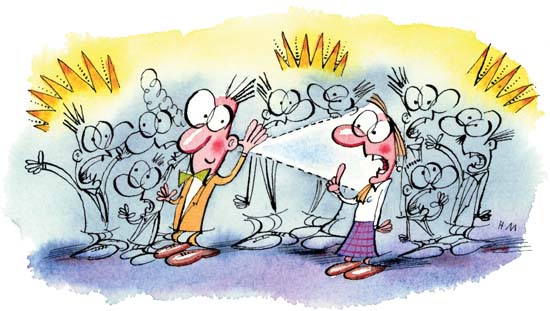 |
 |
| current issue |  | past issues |  | send a letter/news |  | address update |  | advertise |  | about us |  | alumni home |
Campus Currents
|
How's That Again?
Using mathematics to improve hearing aids |
Easy to print version |
 Illustration by Hal Mayforth |
If you think your boss is picky, it's a good thing you're not a software developer for math professor Kevin Short, whose latest spinoff is using his signal-processing knowledge to develop hearing aids that can mimic, and potentially resolve, the "cocktail party" syndrome.
"If there's a 10-to-minus-8th error in a test case, I'll jump up and down and say no way," he says, exaggerating a bit on his reaction but not on the need for precision. "The mathematics is quite tricky. Everything affects everything else—that's the thing that shocks people."
Short is no stranger to the trickiness of taking mathematical tools from the blackboard to the real world. In 2008 he won a Grammy for his role in the restoration of a 1949 Woody Guthrie recording, which involved using tools from his work in music compression technologies to find patterns within the chaos of a badly deteriorated recording from the days when recordings were made on wire. In 2001, he was behind UNH's first spinoff company, Chaoticom, which used math to improve music compression; the firm became Groove Mobile, a pioneer in downloadable music for cellphones, and was sold to NMS Communications in 2008.
This summer, local angel investors put $1.3 million behind Setem Technologies, the fifth UNH spinoff. It has licensed some of Short's patents filed through UNH, seeking ways to better sort through the many streams of sound we hear in everyday life. While there's no schedule yet for a product release, the potential market is huge: hearing-aid wearers who want to hear the important sounds, just as our unaided ears can pick out and follow a single conversation amid the babble of a party.
"Super-resolution of frequencies allows me to track what's going on with a signal in such a way that I really get a good mathematical representation of the source," says Short. The key breakthrough came when he realized that with improved signal accuracy, he could spot different sources by plotting the frequency over time.
If signals can be separated, they can be tracked. "We have started testing it in the real world and have been able to do some interesting demos," says Short. "We held a hand-held field recorder at arm's length, walked by a car alarm going off and spoke naturally, and we have been able to separate those signals."
blog comments powered by Disqus

